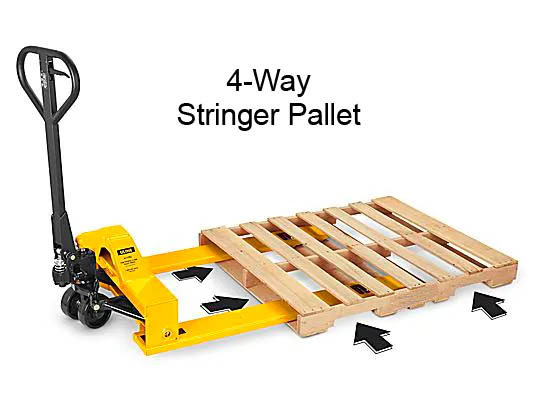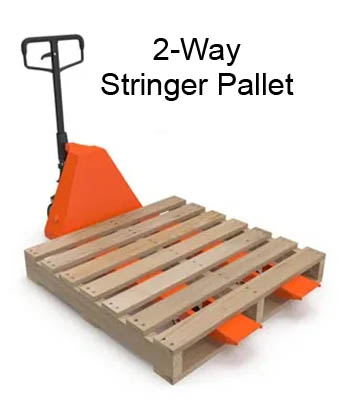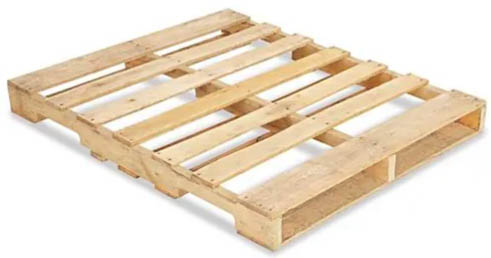Across numerous industries, businesses of all types that need to transport goods from manufacturing facilities to warehouses to distributors to retailers rely on wooden pallets to facilitate the movement of those goods. Items of almost any type can be stacked and fastened to pallets, which provide a stable platform transforming a pile of boxes or containers into a single unit that can readily be moved with a forklift or hand-truck.
In broad terms, two classifications of shipping pallets are manufactured: stringer pallets and block pallets. These distinctions refer to the physical design of the pallets and the way the two horizontal decks are joined together.
 Stringer pallets have decks connected with beams (called stringers) that run the length of the pallet; these beams can be solid or notched – a distinction to be addressed shortly.
Stringer pallets have decks connected with beams (called stringers) that run the length of the pallet; these beams can be solid or notched – a distinction to be addressed shortly.
Block pallets are joined together with rectangular or cylindrical spacers (called blocks), between six and nine in number depending on the construction of the pallet.
Currently stringer pallets significantly dominate the market, with 76 percent of newly constructed pallets being stringer pallets, in comparison with only 21 percent block pallets. This gap only increases for recycled and remanufactured pallets, with this group consisting of 91 percent stringer pallets.
To provide a frame of reference, approximately 2 billion wooden pallets are currently in use throughout the United States, and roughly one-fourth of them are replaced each year.
The primary difference between stringer pallets and block pallets depends on the perspective from which the matter is considered:
- For the manufacturer the most salient difference lies in cost to produce the pallets
- For the companies using the pallets, the major difference between the two designs involves the way they can be accessed by forklift or hand-truck. This is also where the distinction between the two types of stringer pallets – notched and unnotched – becomes relevant.
The most popular size of pallet (the closest that exists to a “standard” size) is 48”x40”, and a stringer pallet constructed to these dimensions uses 15.8 board feet of wood, while a block pallet with the same measurements requires 23 feet of wood – nearly 1.5 times the amount of material. Predictably, this makes block pallets more expensive to produce.
 The chief advantage that block pallets have over stringer pallets, which causes some companies to prefer to use them, is that block pallets are fully accessible to forklifts and hand-trucks from any of their four sides. An un-notched stringer pallet can only be accessed by forklift or hand-truck from the two narrower, 40” sides.
The chief advantage that block pallets have over stringer pallets, which causes some companies to prefer to use them, is that block pallets are fully accessible to forklifts and hand-trucks from any of their four sides. An un-notched stringer pallet can only be accessed by forklift or hand-truck from the two narrower, 40” sides.
Some stringer pallets are constructed with two notches in each of the three stringer beams that run the length of the pallet. These notches allow forklifts to access the pallet from the long, 48” sides. However, hand-trucks cannot utilize these notches, because accessing the pallet this way does not allow the operator to benefit from the stabilization provided by the bottom deck boards.
In addition, the presence of notches in the stringer beams creates narrower areas in these supports, compromising the strength of the pallet. Notched stringer pallets are, in this respect, a sort of compromise between strength and flexibility of use, and serve as a way of providing some of the increased accessibility that characterizes block pallets without the large jump in materials cost, but at the price of some durability.
The question of durability does factor into cost over time, of course. Repairing, recycling, and remanufacturing wooden pallets can yield a significant cost savings compared to constructing new pallets from raw materials. When used pallets are collected by Greenway Products & Services. Collected pallets are then sorted into three categories:
- repairs unnecessary
- repairs needed, and
- repairs impossible
Undamaged pallets are ready to return to circulation without any modification. Pallets in need of repair may need replacement blocks, new fasteners, or to have broken stringers reinforced with companion stringers or metal plates. Pallets that cannot be repaired may be dismantled and the unbroken pieces used to remanufacture new pallets, at a cost savings of roughly 20 to 40 percent compared to a new pallet made from fresh lumber. By comparison, recycled pallets save approximately 70 percent over newly fabricated pallets. Pieces that cannot be used to remanufacture additional pallets are often shredded into other products such as animal bedding, mulch, biofuels, or wood fiber.
While stringer pallets still considerably dominate the pallet market, trends are moving in ways that call their continued dominance into question. Since 2011, the proportion of block pallets in use has been slowly but steadily increasing, while the proportion of stringer pallets in use has been declining within the same time frame; the current proportion of stringer pallets in circulation is at its lowest level since 1999. Time will tell if this trend persists into the future, but at present, stringer pallets continue to reign supreme.
Greenway Products & Services, LLC is the largest pallet remanufacturer and recyclers in NY, NJ, PA, MD, and DE. We also accept scrap wood from our customers that we turn into valuable resources. Greenway is a highly rated, full-service pallet management company. Contact us for a quote today at sales@greenwaypsllc.com. Visit our website, greenwaypsllc.com or call us at 732-442-0200. We can deliver trailers to you on a moment’s notice throughout the NY-NJ-PA-MD-DE area.




Leave A Comment